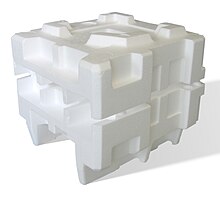Polystyrene is a synthetic polymer discovered in 1839 by Eduard Simon that revolutionized packaging and insulation materials.
Chemical Properties and Structure
Polystyrene forms from styrene monomers through polymerization, creating a naturally transparent and rigid plastic. The material exists in both solid and foamed states, with general-purpose polystyrene being clear, hard, and relatively inexpensive.
Historical Development
The journey from discovery to commercial use spans nearly a century. In 1931, I.G. Farben began manufacturing polystyrene in Ludwigshafen, developing an innovative extrusion process that produced polystyrene pellets. The breakthrough came in 1944 when Ray McIntire patented Styrofoam, working with Dow Chemical.
Applications and Uses
Polystyrene serves multiple purposes:
- Protective packaging
- Food containers
- Building insulation
- Optical disc cases
- Disposable cutlery
Environmental and Safety Concerns
The material presents several challenges:
Environmental Impact
Polystyrene persists in the environment as it’s non-biodegradable. Recent research shows potential toxicity through microplastic particles, which can affect human cells in size-dependent and concentration-dependent ways.
Safety Considerations
The material shows poor heat resistance and can release harmful chemicals when exposed to high temperatures. In building applications, firefighters have noted concerns about melting and burning characteristics[7].
Recent Innovations
Scientists have developed a green, low-energy process to break down polystyrene using ball-milling technology at room temperature. This breakthrough operates at temperatures around 300°C lower than traditional thermal decomposition methods.
Practical Applications
For insulation purposes, polystyrene offers good thermal properties but ranks below modern alternatives like Celotex or Kingspan in performance. When using it for construction, proper vapor barriers and fire-rated covering materials become essential.
Citations:
- https://en.wikipedia.org/wiki/Polystyrene
- https://www.sciencedaily.com/releases/2021/03/210317181624.htm
- https://forums.moneysavingexpert.com/discussion/5188280/expanded-polystyrene-for-wall-insulation
- https://www.gonplastics.com/a-polystyrene-advantages-and-disadvantages.html
- https://polystyrenerecycling.co.za/the-history-of-polystyrene/
- https://pmc.ncbi.nlm.nih.gov/articles/PMC7193629/
- https://www.safelincs-forum.co.uk/topic/3945-are-polystyrene-slabs-a-fire-hazard/
Polystyrene (PS) /ˌpɒliˈstaɪriːn/ is a synthetic polymer made from monomers of the aromatic hydrocarbon styrene. Polystyrene can be solid or foamed. General-purpose polystyrene is clear, hard, and brittle. It is an inexpensive resin per unit weight. It is a poor barrier to air and water vapor and has a relatively low melting point. Polystyrene is one of the most widely used plastics, with the scale of its production being several million tonnes per year. Polystyrene is naturally transparent, but can be colored with colorants. Uses include protective packaging (such as packing peanuts and optical disc jewel cases), containers, lids, bottles, trays, tumblers, disposable cutlery, in the making of models, and as an alternative material for phonograph records.
 | |
 | |
 | |
| Names | |
|---|---|
| IUPAC name Poly(1-phenylethylene) | |
| Other names Thermocol | |
| Identifiers | |
| Abbreviations | PS |
| ChemSpider |
|
| ECHA InfoCard | 100.105.519 |
CompTox Dashboard (EPA) | |
| Properties | |
| (C8H8)n | |
| Density | 0.96–1.05 g/cm3 |
| Melting point | ~ 240 °C (464 °F; 513 K) for isotactic polystyrene |
| Boiling point | 430 °C (806 °F; 703 K) and depolymerizes |
| Insoluble | |
| Solubility | Soluble in benzene, carbon disulfide, chlorinated aliphatic hydrocarbons, chloroform, cyclohexanone, dioxane, ethyl acetate, ethylbenzene, MEK, NMP, THF |
| Thermal conductivity | 0.033 W/(m·K) (foam, ρ 0.05 g/cm3) |
Refractive index (nD) | 1.6; dielectric constant 2.6 (1 kHz – 1 GHz) |
| Related compounds | |
Related compounds | Styrene (monomer) |
Except where otherwise noted, data are given for materials in their standard state (at 25 °C [77 °F], 100 kPa). | |



As a thermoplastic polymer, polystyrene is in a solid (glassy) state at room temperature but flows if heated above about 100 °C, its glass transition temperature. It becomes rigid again when cooled. This temperature behaviour is exploited for extrusion (as in Styrofoam) and also for molding and vacuum forming, since it can be cast into molds with fine detail. The temperatures behavior can be controlled by photocrosslinking.
Under ASTM standards, polystyrene is regarded as not biodegradable. It is accumulating as a form of litter in the outside environment, particularly along shores and waterways, especially in its foam form, and in the Pacific Ocean.

